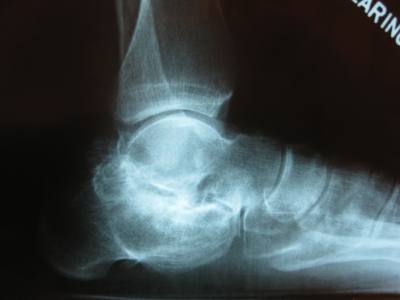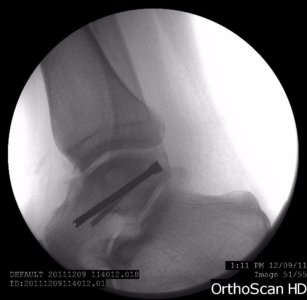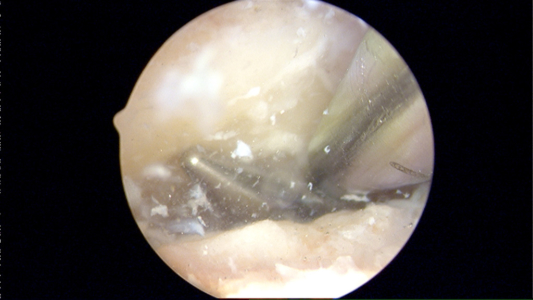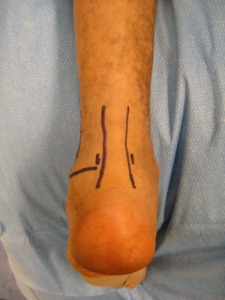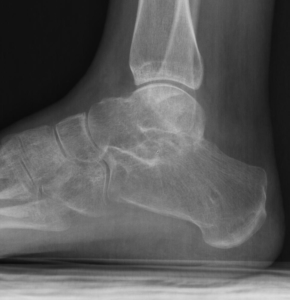Length of Hospital Stay: Outpatient
Length of Procedure: Approximately 1 hour
Anesthesia: General with a regional popliteal block
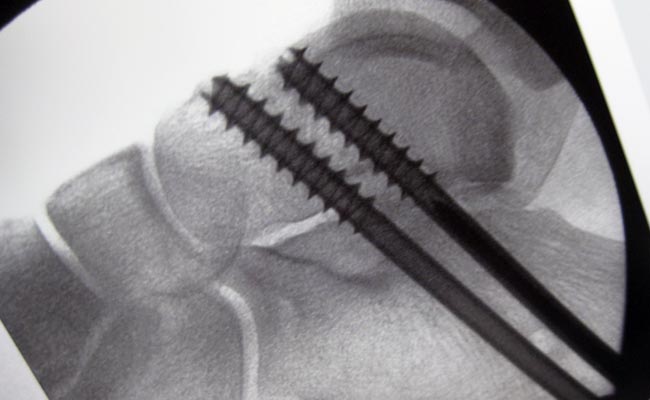
Subtalar arthroscopy – also referred to as hindfoot arthroscopy – is a surgical procedure in which the inside of the joint is examined and treated using a camera and instrumentation that are inserted through small incisions typically one centimeter in length (called portals). Two or three small portals are typically used to perform the procedure. This minimally invasive technique is useful in treating a number of different problems inside the joint, including sinus tarsi syndrome, scarring, posterior impingement, removal of loose bodies, removal of os trigonum, subtalar fusion, release of the flexor hallucis longus tendon, bursectomy, and removal of Haglund’s deformity. Compared to traditional open incisions, the advantages of arthroscopy include earlier rehabilitation, an accelerated rehabilitation course, less pain and blood loss, and a lower rate of infection. Additional procedures may be performed based on the abnormalities found at surgery.
When the arthroscope is taken out, the incisions are closed using sutures. A boot or splint is applied, and the sutures usually are removed approximately 1 week later.
Loose Body Removal of the Posterior Ankle and Hindfoot
In this soundless video, Dr. Dominic Carreira removes loose bodies from the posterior ankle and hindfoot of a patient, via arthroscopic surgery. Dr. Carreira performed the minimally invasive surgery, following the discovery of those loose bodies via an MRI. The loose bodies were actually pieces of cartilage and bone within posterior ankle and hindfoot.
In an appointment with Dr. Carreira, the patient reported feeling an occasional sharp pain in the ankle, as though “something was going out of place.”
The minimally invasive arthroscopic surgery lasted about 20 minutes. This arthroscopic technique is associated with less pain and a faster recovery time for the patient than with open surgery. Within a week of the surgery, the patient was able to walk on the ankle wearing a boot.
Risks of Subtalar Arthroscopy
The main risks associated with subtalar arthroscopy are bleeding, infection, deep vein thrombosis (DVT or blood clot), or damage to superficial nerves of the skin. These risks are very low. Medication, ice, rest, compression, and therapy reduce post operative pain. Complications related to anesthesia are rare but can also occur, as with any surgery. Dr. Carreira may review additional risks with you that are specific to your condition. These risks are lower that with the traditional, larger, open incisions.
Rehabilitation
Our rehabilitation protocol requires strict compliance for optimal results. Weight-bearing as tolerated, Toe-Touch weight-bearing, Partial weight-bearing or Non-weight bearing status will be determined by Dr. Carreira during surgery. The length of protected weight bearing will also be determined at the time of surgery. You will have the aid of crutches, a wheelchair, or roll-about postoperatively for a minimum of 1 week. At your first visit after surgery Dr. Carreira will discuss if physical therapy is needed.
Keep your dressing clean and dry at all times. After your bandage is removed at the first office visit, you may shower as usual. Wash the incision gently with soap and water, pat it dry and apply a clean, dry dressing or Band-aid. No ointments are needed on the incisions.
Driving and Flight Information
You will be given a narcotic to help relieve your pain. Legally, you are not allowed to operate heavy machinery (this includes cars!) while on narcotics. Dr. Carreira will discuss return to driving in detail with you at your first visit after surgery.
With regards to flying, during the time that you are not fully weight bearing, precautions should be followed closely to prevent blood clots. This typically includes the use of an injectable blood thinner.
Return to Work
You may return to sedentary work one week after surgery, as long as the pain is well-controlled. However, you must take the time to go to your office visits, and you must follow all post-operative instructions carefully while at work. Returning to heavy labor or sports will be determined by your progression through physical therapy (if needed) and by the extent of damage in your foot.
Follow Up Appointments
Desired appointment intervals for Dr. Carreira’s patients are 2 weeks, 6 weeks, 12 weeks and 6 months.
- Always feel free to contact us with your concerns and questions.*


